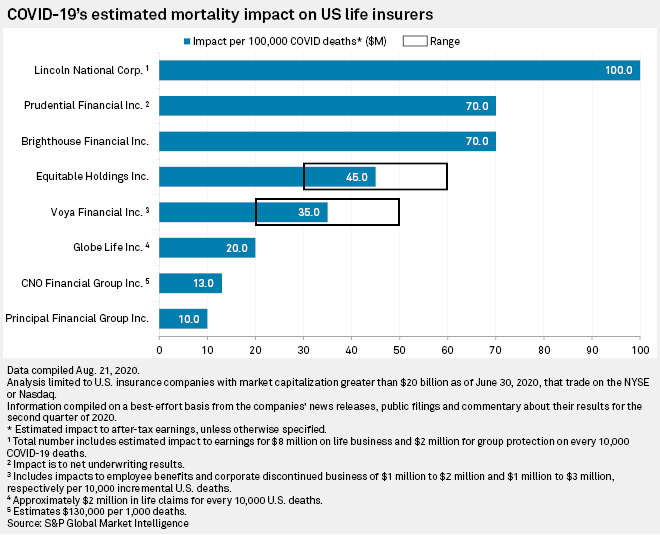The escalating U.S. death toll from the coronavirus pandemic is having an effect, albeit a limited one, on life insurers' finances, while their long-term care businesses are reporting lower claims levels given concerns surrounding assisted living facilities.
Several public U.S. life insurers made passing comments about elevated mortality during their second-quarter earnings calls, which could leave them exposed to higher payouts on life policies. But analysts noted that, thus far, the financial impact of policyholder deaths is less than what had been previously guided by most companies.
In Prudential Financial Inc.'s Form 10-Q, the company said it expects the pandemic to drive elevated levels of mortality in the near term and noted that it may "ultimately result in a mortality calamity," which it described as the risk that short-term mortality rates deviate adversely from what is expected to result from certain disasters.
"Ultimate losses would depend on several factors including the rates of mortality and morbidity among various segments of the insured population, age distribution of associated deaths, collectability of reinsurance, performance of our investment portfolio, effect on lapses and surrenders of policies, as well as sales of new policies and other variables," the regulatory filing stated.
Piper Sandler analyst John Barnidge noted that Prudential reduced its sensitivity to COVID-19 by roughly 50% when it reported second-quarter earnings.
"From that perspective it suggests to me that it's less material than before," Barnidge said. "I think it's an earnings event and not a capital event by any means."
With the U.S. recording about 120,000 U.S. virus deaths by the end of the second quarter, Brighthouse Financial Inc. had $25 million, pretax in net claims related to the pandemic, which executives noted on the earnings call was "much better" than the guidance of $70 million after tax per 100,000 deaths that was previously given on its first-quarter call.
Although companies are seeing COVID-19 mortality increases that are driving greater mortality overall, Barnidge pointed out that Lincoln National Corp. was one of only a fraction of insurers to actually increase its sensitivity to the pandemic.
"We estimate that COVID-related claims reduced earnings by approximately $125 million to $145 million, or 65 cents to 75 cents per share ... slightly above the mortality sensitivity we provided previously," an executive said on Lincoln's second-quarter call.
Lincoln expects every 10,000 COVID-19 deaths in the U.S. will equate to an earnings impact of about $10 million.
CNO Financial Group Inc. adjusted its mortality projections to be for 150,000 to 400,000 U.S. COVID-19 deaths as having an expected $20 million to $52 million net mortality impact and $130,000 per 1,000 deaths. Previously, CNO had guidance for 80,000 to 120,000 deaths at a $20 million to $30 million net mortality impact and $250,000 per 1,000 deaths.
"Unfortunately we are seeing more mortalities than originally anticipated, but the expected claims per U.S. mortality are lower than expected," Credit Suisse analyst Andrew Kligerman explained. "There's somewhat of an offsetting effect there."

Long-term care blocks benefit
Insurers in recent years have been pressed to obtain rate increases on long-term care blocks, but as the pandemic has lowered claims levels and driven lower benefits from individuals deciding not to put their parents in nursing homes, Barnidge said the need for rate increases may actually be reduced.
Ameriprise Financial Inc. reported pretax adjusted operating earnings of $17 million for the second quarter in its long-term care segment, which reflected a drop in policyholders entering nursing homes, as well as increased mortality-related terminations.
"Normally it would have been break even to a slight loss, so from that perspective its been a beneficiary for them," Barnidge said.
Unum Group executives during a second-quarter earnings call said the long-term care line within its closed block had a positive quarter, thanks to elevated claim mortality, which was roughly 30% higher than average for the period. Higher mortality was not observed in the active lives block for that quarter.
Unum's new claim incidents for long-term care were also described as favorable, driven by what they believe is a hesitancy toward nursing homes or assisted living facilities. The insurer increased its incurred but not reported reserve for long-term care by an incremental $20 million.
A Genworth Financial Inc. executive said the company also saw a decrease in new claims submissions on its older long-term care blocks in the second quarter, But that is expected to be temporary because of delays in reporting claims due to social distancing and shelter-in-place protocols. Genworth expects its incidence experience will "ultimately resemble previous trends," which is why the company added to its IBNR reserve.
Genworth also saw claim and active policy terminations in long-term care that were "significantly" higher in the second quarter than in the prior quarter and prior year.
Kligerman said he expects the trend of lower claims levels in long-term care to continue into the back half of the year as well.



